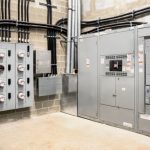The Basics of Pump Control Panels

What Are Pump Control Panels?
Pump control panels are electrical cabinets that house the controls and monitoring devices required for the operation of a pump. They are typically installed adjacent to the pump, often in a control room or a separate enclosure. These panels are responsible for starting and stopping the pump, protecting it from various operating conditions, and monitoring critical parameters such as flow rate, pressure, and temperature.
Components of Pump Control Panels
Pump control panels consist of several components, each serving a specific purpose in the operation of the pump system. The primary components include:
1. Motor starter: This component is responsible for starting and stopping the electric motor that drives the pump. It ensures that power is supplied to the motor in a controlled manner, preventing sudden surges or fluctuations that could damage the equipment.
2. Control switches and indicators: These switches and indicators are used to manually control the operation of the pump. They allow operators to start and stop the pump, as well as monitor its status and any alarms or faults that may occur.
3. Protection devices: Pump control panels incorporate a range of protection devices to safeguard the pump and its associated equipment. These devices include circuit breakers, fuses, and overload relays, which are designed to detect and interrupt power in the event of an electrical fault or motor overload.
4. Sensors and transducers: These devices are used to measure critical parameters such as flow rate, pressure, and temperature. They provide feedback to the control panel, allowing it to adjust the operation of the pump based on the system’s requirements.
5. Communication interfaces: Some pump control panels feature communication interfaces that allow remote monitoring and control of the system. These interfaces enable operators to access the panel’s status and data remotely, facilitating faster troubleshooting and maintenance.
Benefits of Pump Control Panels
Pump control panels offer several benefits that enhance the performance and reliability of water pumping systems. Some of these benefits include:
1. Automatic operation: Pump control panels enable automated operation of the pump, eliminating the need for manual intervention. This ensures consistent and efficient operation, even in unmanned or remote locations.
2. Energy efficiency: By monitoring and adjusting pump operation based on system demands, control panels optimize energy consumption. They prevent unnecessary pump starts and stops, reducing energy wastage and extending equipment lifespan.
3. System protection: Pump control panels incorporate various protective devices that prevent equipment damage and failure. By continuously monitoring system parameters, they can detect abnormal conditions and activate alarms or shut down the pump to prevent further damage.
4. Enhanced maintenance and troubleshooting: With sensors and communication interfaces, pump control panels simplify maintenance and troubleshooting processes. They provide real-time data and alerts, enabling operators to quickly identify and address issues, reducing downtime and repair costs.
Summary
Pump control panels are essential components of water pumping systems, providing control, protection, and monitoring capabilities. Understanding the basics of these panels is crucial for anyone involved in the design, installation, or maintenance of pump systems. By incorporating pump control panels, operators can improve efficiency, reliability, and safety in water pumping operations.
Need Pumping Equipment in Sunrise Beach, MO?
Categorised in: Pump Control Panels
